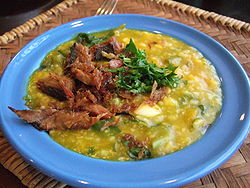 Tinutuan with salted fish | |
| Alternative names | Bubur Manado |
|---|---|
| Course | Main |
| Place of origin | Indonesia |
| Region or state | Minahasa, North Sulawesi |
| Serving temperature | Hot |
| Main ingredients | Rice congee with vegetables |
Tinutuan, also known as bubur manado or Manadonese porridge , is a specialty of the Manado cuisine and a popular breakfast food in the city of Manado and the surrounding province of North Sulawesi, Indonesia. [1] [2] [3]



